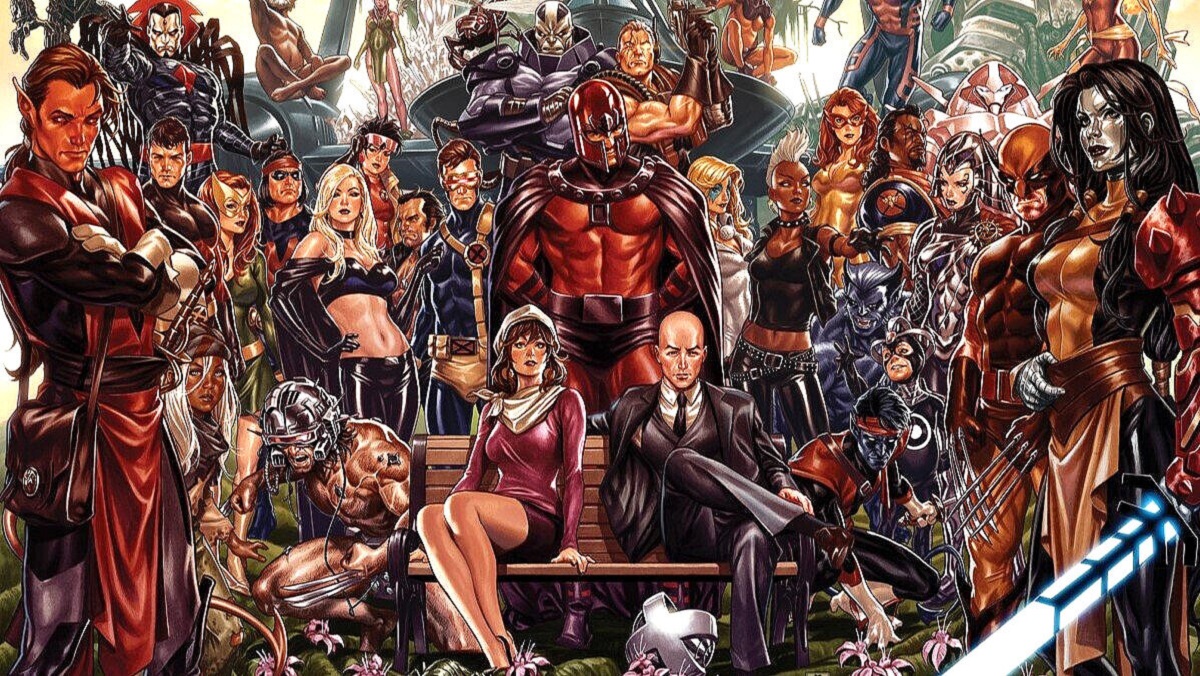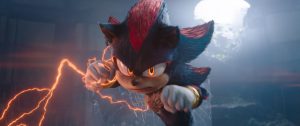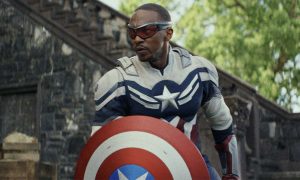
X-Men comics have always been about the future. They are, after all, stories about mutants, the next stage in human evolution. The central tension dividing Professor Charles Xavier and his best friend Magneto is how to go into that future, either working with humanity or ruling them.
X-Men comics have also always been very, very confusing, with their frequent tales of clones, shape-changers, and alternate realities.
Given those two facts, it’s no wonder that X-Men creators would embrace time travel as a storytelling conceit, throwing Marvel’s Merry Band of Mutants far into the future or launching them deep into the past. The results vary, but these fifteen tales represent the best, and sometimes most headache inducing, of the X-Men’s adventures across time.
Photo: Marvel Comics.
15. Days of Future Present (1990)
The 1990 crossover Days of Future Present is only half an X-Men story, as Franklin Richards is the main character. The son of Reed and Sue Richards, Franklin spins out of Fantastic Four comics. However, Franklin is a mutant (well, used to be, until a recent ret-con and the coldest of shoulders from Professor X), and thus his future self concerns the X-Men.
Days of Future Present comes at a transitional point in X-Men history, with longstanding writers Chris Claremont and Louise Simonson losing control over the plots and flashy artists Jim Lee and Rob Liefeld gaining influence over story beats. As a result, Days of Future Present has lots of splash pages, lots of shouting, but not so much in the way of character development. It’s always fun to see Franklin as a powerful kid mutant, but the the storyline doesn’t offer much more beyond that.
Photo: Marvel Comics.
14. “Cable” (Ultimate X-Men #75 – 78, 2006 – 2007)
Of all the original Ultimate Comics series, Ultimate X-Men may have aged the worst. At once too edgy and hip for its own good, while also repeating too many beats from the mainline series, the comic managed to irritate everyone and please no one. So many reacted with a sigh when the first appearance of Ultimate Cable ends with popping claws three claws and telling Wolverine, “This is it, bub.”
Yes, in the Ultimate Universe, Cable is not the long-lost son of Cyclops and Madelyne Pryor, but Wolverine, who became a cyborg to off-set his depleted healing factor. He’s come back for… something. But his goal doesn’t really matter, because Ultimate Bishop arrives almost immediately after, leading to a knock-down battle between time travelers with the X-Men in between. Writer Robert Kirkman deserves credit for a twist on the Cable mythos, and pencilers Ben Oliver and Yanick Paquette make the fight scenes pop. But there’s not much to the storyline beyond the Wolverine reveal.
Photo: Marvel Comics.
13. X-Cutioner’s Song (1993)
When Cable showed up in 1990’s The New Mutants #8, he was just a time traveling tough guy with giant guns and tiny feet. His backstory was a secret (or, undeveloped), following in the vein of Wolverine and Gambit. But as Marvel published more and more Cable stories, it became clear that he had a much deeper connection to the X-Men. The 1992-1993 crossover event X-Cutioner’s Song clarified things. Cable was not Nathan Christopher Charles Summers, the son of Madelyne Pryor and Cyclops. Rather, Nathan grew up to be the villain Stryfe and Cable was his clone.
At least, that’s what we thought. But later stories have established the opposite, with Cable as the real son and Stryfe as the clone. (Hey, it’s Marvel in the ’90s; of course they’re going to make a mess of their clones). Even before that reversal, X-Cutioner’s Song confuses more than it clarifies. On the surface, it’s about Stryfe getting revenge on the X-Men, Apocalypse, and Cable. That said, the enjoyment of X-Cutioner’s Song isn’t contingent on it making sense, as it delivers more than enough mutant-on-mutant action.
Photo: Marvel Comics.
12. “Berserker” (Old Man Logan #1 – 4, 2016)
As anyone who has seen Logan knows, Old Man Logan is not a time travel story. Rather, it’s an alternate universe tale in a potential future, in which the haggard and bitter Wolverine gets called back into action for a lot of Mark Millar edge lord nonsense. In the same way that Logan improved on the original story from Millar’s 2008 Wolverine run with Steve McNiven, the follow-up ongoing Old Man Logan from 2016.
The first arc from Old Man Logan finds the elderly Wolverine transported in the present, before the Wasteland has has developed and with his friends still alive. Yet, Old Man Logan remains haunted by the memory of things to come, terrified that it will happen again. With “Berserker,” writer Jeff Lemire and artist Andrea Sorrentino revisit the classic Logan conflict between person and beast by giving readers a Wolverine who knows that he’s killed his friends.
Photo: Marvel Comics.
11. “Here Comes Tomorrow” (New X-Men #151-154, 2004)
When Grant Morrison took on the X-Men in 2001, they revitalized the franchise in ways that continue to resonate even today. But for all of the run’s high points, it ended on an uneven note. “Here Comes Tomorrow” mostly takes place 150 years after the previous story, which climaxed with Magneto, addicted to a drug called Kick, killing Jean Grey and leaving Scott heartbroken. Beast tries to take his place but, as happens kinda often with Beast, he goes mad and becomes an ageless tyrant who rules the world.
If that sounds high-concept, well, it is Grant Morrison. Unfortunately, Morrison’s heady style clashes with the pencils from Marc Silvestri, an artist who did great work with Claremont back in the late ’80s but has lost some storytelling skills by the time he returns. Between Morrison’s oddball ideas and Silvestri’s unclear pencils, much of “Here Comes Tomorrow” reads like a mess. That is, until, the return of Jean Grey allows the heroes to go back to the past, making a nice setup for Joss Whedon’s Astonishing X-Men.
Photo: Marvel Comics.
10. X-Men: Battle of the Atom (2012)
Speaking of Beast doing crazy things, Hank McCoy crossed a real ethical line when he went back in time to bring his younger self and the other four original X-Men, still teens studying under Xavier, into the present. In Hank’s defense, things had gotten bad. Pushed to the limit, Cyclops became a militant, taking half the team with him. In a desperate attempt to talk some sense in his old self and reunite the X-Men, Beast brought the teen team to talk some sense into their older selves.
Of course, it didn’t work, as demonstrated by Battle of the Atom. As the teens resist attempts to send them back to the past, the X-Men of the future arrive and demand they go back. But when the present X-Men realize that the future X-Men are in fact the future Brotherhood of Evil Mutants, they fight to keep the past X-Men here. Confused? Well, you should be. But at least the creative team, including writers Brian Michael Bendis and Jason Aaron as well as artists Frank Cho and Stuart Immonen keep things entertaining.
Photo: Marvel Comics.
9. “Tooth and Claw” (X-Men #8, 1992)
Like Cable, Lucas Bishop came to the X-Men from a ravished future, bearing a gun and a bad attitude. And like Cable, he wasn’t entirely trustworthy, as he kept under wraps his mission to prevent the dystopian future from which he hailed. However, in X-Men #8, Jim Lee and Scott Lobdell add another juicy twist to Bishop’s story when he meets the X-Men Blue Team for the first time. While impressed to shake hands with the great Cyclops, Bishop loses his cool at the sight of Gambit, branding the Cajun mutant a traitor.
Really, Bishop did Gambit a favor. For years, questions about Gambit’s trustworthiness gave him a new edge of cool among readers. But X-Men #8 doesn’t get into any of that. Instead, it’s a splashy issue full of Jim Lee cheesecake and beefcake, in which the Gambit and Bishop battle climaxes with a pie in Rogue’s face. Bishop’s mission and Gambit’s betrayal will later become major plot points. But in “Tooth and Claw,” they’re just an excuse for mutant shenanigans.
Photo: Marvel Comics.
8. The Adventures of Cyclops and Phoenix (1994)
Remember how I said the future identity of Nathan Summers would get clarified later on? Well, that happens in the miniseries The Adventures of Cyclops and Phoenix. And “clarified” might be too strong a word. The story begins with Jean and Scott’s other time-displaced kid Rachel Summers, now an elderly woman, pulling her the consciousness of her parents into new bodies in a future conquered by Apocalypse. They’re joined by the infant Nathan Summers, who has been stashed in this reality to train for an eventual stand-off with Apocalypse.
The Adventures of Cyclops and Phoenix does the readers no favors by throwing them into a disoriented time frame, complete with lots of word balloons and unfamiliar versions of Cyclops and Jean Grey. But after that first issue, writer Scott Lobdell and penciler Gene Ha zero in on the emotional stakes of the story. Under the assumed names Slym and Redd Dayspring, Cyclops and Phoenix get to be the parents they never were, raising Nathan before returning to their time without memories of the occasion. It’s a strangely sweet story, hidden under complex time travel mechanics.
Photo: Marvel Comics.
7. Cable #10 – 12, (2021)
If you’re rolling your eyes at the sight of another Cable story on this list, rest assured — this one is much easier to follow. The fourth Cable ongoing series, launched in 2021, follows Nathan Summers in his late teens, having gone back further in time to kill his apparently corrupted older self. Okay, that is a bit confusing, but it mostly comes down to grizzled old Cable being replaced by young excitable Cable.
At least until the end of the third series. In the final three issues of that run, written by Gerry Duggan and Phil Noto, young Cable encounters his older arch-enemy Stryfe. Stryfe has stolen mutant children from the island of Krakoa, but the young Cable can find no way to stop him. In an act of desperation, Cable finds his older self, resulting in a delightful and unlikely team-up.
Photo: Marvel Comics.
6. Marvel 1602 (2003 – 2004)
Every story on this list is confusing to some degree, but by putting magic at the center of its time travel tale, Marvel 1602 outdoes them all. The product of Neil Gaiman and penciler Andy Kubert, Marvel 1602 involves not just the X-Men but the entire Marvel Universe. Furthermore, it mostly reads like an alternate universe story, in which recognizable heroes take surprising forms. Nick Fury, Agent of Shield becomes Sir Nicholas Fury, spymaster for Queen Elizabeth I. Explorer Sir Richard Reed takes his family aboard his sailing vessel the Fantastick. And Charles Xavier becomes Spaniard Carlos Javier, who runs a school for the hated and feared witch breed.
The time travel aspect of Marvel 1602 doesn’t become clear until late in the series, and even then has a more metaphorical and scientific bent, as one would expect of Gaiman. Even before then, though, the early 17th century take on mutants allows readers to see different ways that hatred takes form, whether in the past or in the future.
Photo: Marvel Comics.
5. Legion Quest (1994 – 1995)
Inspired by an episode of X-Men: The Animated Series, the 1995 storyline Age of Apocalypse stands as the brightest point of 90s X-Men comics. Set in an alternate present ruled by Apocalypse, the Age of Apocalypse came to be when Xavier’s troubled son Legion travels back in time and kills his father before the X-Men can be formed.
Before Age of Apocalypse came Legion Quest, a six-part story that crossed between X-Factor, Uncanny X-Men, X-Men, and Cable. While the storyline has more than its fair share of the big poses and hyper-crosshatched artwork common to ’90s X-Men comics, it also has a tragic heart at the center. An incredibly powerful but deeply troubled person, Legion wants nothing more than to please his father, which he hopes to do by going back to kill Magneto. Even before the story reaches its tragic end, it pits Legion against Xavier’s students, the children he truly loves over his own neglected son.
Photo: Marvel Comics.
4. House of X/Powers of X (2019)
When Jonathan Hickman took over the X-Men universe, he introduced a number of radical concepts, including the Resurrection Protocols that make mutants functionally immortal and a sovereign nation in the island Krakoa. But the most controversial change may have been to Moria McTaggert, a longtime human ally to the X-Men. In the twin miniseries House of X and Powers of X, which launched the Krakoa era, Hickman revealed Moira to be a mutant, one who could resurrect with the memories of her past lives.
Thanks to this shift, House of X and Powers of X is a time travel story, although it doesn’t function like one. Each of Moira’s lives involve timelines, some of which end in childhood and others that go one for millennia. And each time she reincarnates, always at the same point in history, she does so with knowledge of those futures. From that concept, Hickman uses Moira as a catalyst for a new imperative, as humans, mutants, and even machines battle to control tomorrow.
Photo: Marvel Comics.
3. Multiple Man #1 – 4 (2018)
In superhero comics, the existence of two (or more) people with the same identity means one of two things: time travel or clones. In the case of Jamie Madrox, it’s both! One of the most criminally underused characters in the X-Men bullpen, Jamie Madrox is the Multiple Man, a guy who has the ability to make perfect duplicates of himself. Madrox usually gets ignored or misused by writers who aren’t Peter David (looking at you, X-Corp), but the miniseries Multiple Man stands as a wonderful exception, thanks to its time travel plot.
Written by Matthew Rosenberg, with art from Andy MacDonald and Tamra Bonvillain, Multiple Man begins in the manner of most new Madrox stories, with the revelation that he is not, in fact, dead. The dead Madrox was, of course, a duplicate. But then this newly-revealed Madrox gets captured by Madroxes from the future, who have the powers of the Hulk, Deadpool, Cloak, and others. These Madroxes take the other Madrox into the future, to join other Madroxes in a resistance against a Madrox who has conquered the world with his army of Madroxes. Mind-boggling? Yes! Delightful? Absolutely!
Photo: Marvel Comics.
2. X-Men: Messiah Complex (2007 – 2008)
Even though the X-Men had two time traveling gun nuts running around since the early ’90s, the two didn’t really come to heads until the 2000s (save short spats, as in the aforementioned X-Cutioner’s Song). But with the 2007 – 2008 crossover Messiah Complex, which ran across all of the X-books at the time, Cable and Bishop finally face off over Hope, the first new mutant born since Scarlet Witch decimated the population in House of M.
For Cable, Hope is exactly what her name suggests, the way toward a better and vibrant future for mutants. But Bishop comes from a future ruled by the Mutant Messiah, which appears to be Hope. As important as this difference of perspectives is, Messiah Complex is about much more than just two buff dudes in a grudge match. Rather, a creative team that includes Ed Brubaker, Mike Carey, Billy Tan, and Chris Bachalo craft a story about the way forward for the X-Men and their status as the next stage in evolution.
Photo: Marvel Comics.
1. “Days of Future Past” (Uncanny X-Men #141 – 142, 1981)
Of course the number one pick is “Days of Future Past.” How could not be? Not only is it a legendary story that has been adapted into every other type of medium, but it remains a model for telling a satisfying time travel story. After all, look again at the headline above. The entirety of “Days of Future Past” occurs across just two issues, telling a complex story with clarity and conciseness. Those qualities come courtesy of one of the greatest collaborations in comic book history, between writer Chris Claremont and artist/co-writer John Byrne.
The premise is simple: after Mystique and the Brotherhood of Evil Mutants murder the hateful Senator Robert Kelly, the bigoted backlash creates a police state ruled by Sentinels. To prevent this from happening, Rachel Summers sends the adult Kate Pryde’s consciousness back to her younger self, then a new recruit on the team, to save Kelly and the future. It’s a classic X-Men story with both creators at the height of their powers, one that keeps its time travel mechanics clean, giving the adventure full emotional heft.
The post The Best X-Men Time Travel Stories Ever appeared first on Den of Geek.


![Best Poker Apps for Real Money in 2024: Top Mobile Poker Apps for iOS & Android [Update]](https://recognizecity.com/wp-content/uploads/2024/08/best-poker-apps-jYZiIp-300x169.jpeg)


